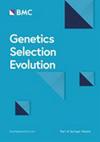COL1A1中的一个复发性从头错义突变导致诺曼底牛II型成骨不全症和早产
IF 3.1
1区 农林科学
Q1 AGRICULTURE, DAIRY & ANIMAL SCIENCE
引用次数: 0
摘要
一头名为 "Ly "的诺曼底人工授精公牛所产的九头公牛犊和八头母牛犊因多发性骨折、妊娠期缩短、死胎或围产期死亡而被转诊至法国国家牛畸形观察站。利用 Illumina BovineSNP50 阵列对患病小牛和 84 个半同父异母对照的基因型分析,相关基因座被映射到 19 号染色体上的一个 6.5 兆字节区间,假定为常染色体遗传与种系镶嵌。随后对一个病例和 5116 个对照基因组的全基因组序列进行了比较,并对受影响的血统进行了基因分型,确定了 COL1A1 基因 NC1 结构域内的一个新的错义置换(Chr19 g.36,473,965G > A; p.D1412N)是唯一的候选变异。有趣的是,受影响的残基在 243 个脊椎动物直系同源物中完全保密,而且据报道,在人类中,相同的置换可导致 II 型成骨不全症(OI),这是一种结缔组织疾病,主要特征是骨骼畸形和脆弱。此外,有报道称三种 COL1A1 基因突变可导致牛患相同的综合征。尸检、计算机断层扫描、放射学和组织学证实了 II 型 OI 的诊断,进一步支持了这种变异的因果关系。此外,通过对 Ly 的 1387 头后代和 63 头对照组公牛的 16 万多头后代的妊娠期长度和围产期死亡率进行详细分析,我们在一个大型血统中统计证实了 II 型 OI 与早产之间的关联,早产可能是由于胎膜早破造成的,在人类和牛的几例 II 型 OI 孤例中均有报道。最后,对围产期死亡率和分离畸变的分析表明,Ly 的生殖细胞嵌合程度较低,估计突变精子的比例为 4.5% 至 7.7%,因此出生的受影响小牛为 63 至 107 头。这些数字与报告的 17 个病例形成鲜明对比,并引发了人们对先天性缺陷向遗传监测平台报告不足的担忧,即使是教科书上的遗传综合征也是如此。总之,我们描述了一个大型动物模型,该动物模型中的 COL1A1 发生了复发性置换,而这种置换是导致人类 II 型 OI 的原因。更广泛地说,这项研究强调了此类数据集和家畜物种中的大型半同父异母家系在描述零星遗传缺陷方面的实用性。本文章由计算机程序翻译,如有差异,请以英文原文为准。
A recurrent de novo missense mutation in COL1A1 causes osteogenesis imperfecta type II and preterm delivery in Normande cattle
Nine male and eight female calves born to a Normande artificial insemination bull named “Ly” were referred to the French National Observatory of Bovine Abnormalities for multiple fractures, shortened gestation, and stillbirth or perinatal mortality. Using Illumina BovineSNP50 array genotypes from affected calves and 84 half-sib controls, the associated locus was mapped to a 6.5-Mb interval on chromosome 19, assuming autosomal inheritance with germline mosaicism. Subsequent comparison of the whole-genome sequences of one case and 5116 control genomes, followed by genotyping in the affected pedigree, identified a de novo missense substitution within the NC1 domain of the COL1A1 gene (Chr19 g.36,473,965G > A; p.D1412N) as unique candidate variant. Interestingly, the affected residue was completely conserved among 243 vertebrate orthologs, and the same substitution in humans has been reported to cause type II osteogenesis imperfecta (OI), a connective tissue disorder that is characterized primarily by bone deformity and fragility. Moreover, three COL1A1 mutations have been described to cause the same syndrome in cattle. Necropsy, computed tomography, radiology, and histology confirmed the diagnosis of type II OI, further supporting the causality of this variant. In addition, a detailed analysis of gestation length and perinatal mortality in 1387 offspring of Ly and more than 160,000 progeny of 63 control bulls allowed us to statistically confirm in a large pedigree the association between type II OI and preterm delivery, which is probably due to premature rupture of fetal membranes and has been reported in several isolated cases of type II OI in humans and cattle. Finally, analysis of perinatal mortality rates and segregation distortion supported a low level of germ cell mosaicism in Ly, with an estimate of 4.5% to 7.7% of mutant sperm and thus 63 to 107 affected calves born. These numbers contrast with the 17 cases reported and raise concerns about the underreporting of congenital defects to heredo-surveillance platforms, even for textbook genetic syndromes. In conclusion, we describe a large animal model for a recurrent substitution in COL1A1 that is responsible for type II OI in humans. More generally, this study highlights the utility of such datasets and large half-sib families available in livestock species to characterize sporadic genetic defects.
求助全文
通过发布文献求助,成功后即可免费获取论文全文。
去求助
来源期刊

Genetics Selection Evolution
生物-奶制品与动物科学
CiteScore
6.50
自引率
9.80%
发文量
74
审稿时长
1 months
期刊介绍:
Genetics Selection Evolution invites basic, applied and methodological content that will aid the current understanding and the utilization of genetic variability in domestic animal species. Although the focus is on domestic animal species, research on other species is invited if it contributes to the understanding of the use of genetic variability in domestic animals. Genetics Selection Evolution publishes results from all levels of study, from the gene to the quantitative trait, from the individual to the population, the breed or the species. Contributions concerning both the biological approach, from molecular genetics to quantitative genetics, as well as the mathematical approach, from population genetics to statistics, are welcome. Specific areas of interest include but are not limited to: gene and QTL identification, mapping and characterization, analysis of new phenotypes, high-throughput SNP data analysis, functional genomics, cytogenetics, genetic diversity of populations and breeds, genetic evaluation, applied and experimental selection, genomic selection, selection efficiency, and statistical methodology for the genetic analysis of phenotypes with quantitative and mixed inheritance.
 求助内容:
求助内容: 应助结果提醒方式:
应助结果提醒方式:


